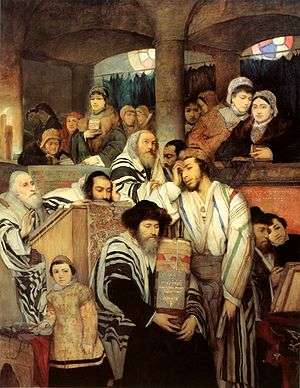Tishrei
- See Tišritum for the Babylonian month.
| ← Elul Tishrei (תִּשְׁרֵי) Marcheshvan → | ||||
|---|---|---|---|---|
 The second holiest day of the Jewish calendar, Yom Kippur, the Day of Atonement, takes place on the 10th of Tishrei. | ||||
| Month Number: | 7 | |||
| Number of Days: | 30 | |||
| Season: | Autumn | |||
| Gregorian Equivalent: | September–October | |||
Tishrei (/ˈtɪʃreɪ/ or Tishri /ˈtɪʃriː/; Hebrew: תִּשְׁרֵי tishré or תִּשְׁרִי tishrí); from Akkadian tašrītu "Beginning", from šurrû "To begin") is the first month of the civil year (which starts on 1 Tishrei) and the seventh month of the ecclesiastical year (which starts on 1 Nisan) in the Hebrew calendar. The name of the month is Babylonian. It is an autumn month of 30 days. Tishrei usually occurs in September–October on the Gregorian calendar.
In the Hebrew Bible, before the Babylonian Exile, the month is called Ethanim (Hebrew: אֵתָנִים - 1 Kings 8:2).
Edwin R. Thiele has concluded, in The Mysterious Numbers of the Hebrew Kings, that the ancient Kingdom of Judah counted years using the civil year starting in Tishrei, while the Kingdom of Israel counted years using the ecclesiastical new year starting in Nisan. Tishrei is the month used for the counting of the epoch year - i.e., the count of the year is incremented on 1 Tishrei.
Holidays in Tishrei
1-2 Tishrei - Rosh Hashanah
3 Tishrei - Tzom Gedaliah – (Fast Day) - On Tishrei 4 when Tishrei 3 is Shabbat
9 Tishrei - Erev Yom Kippur
10 Tishrei - Yom Kippur – (Fast Day)
15–21 Tishrei - Sukkot/Sukkos
- 21 Tishrei - Hoshanah Rabbah
22 Tishrei (and 23 outside of Israel) - Shemini Atzeret/Atzeres & Simchat Torah/Simchas Torah
Tishrei in Jewish history and tradition
- 1 Tishrei (c. 3760 BC) - Adam & Eve were created, according to one opinion in the Talmud.
- 1 Tishrei (1923 AD) - Daf Yomi study regimen is launched.
- 2 Tishrei (1659 AD) - HaRav Tuvya and HaRav Yisroel were murdered in a blood libel in Razino.
- 3 Tishrei (c. 582 BC) - Assassination of Gedaliah; now a fast day. (According to many opinions, the assassination actually occurred on Rosh Hashanah, but the commemoration of the event is postponed to the day after the festival).
- 4 Tishrei (1683 AD) - King Louis XIV expelled the Jews from all French territories in America.
- 5 Tishrei (134 AD) - Rabbi Akiva tortured and executed.
- 6 Tishrei (1939 AD) - The Wehrmacht murdered 100 Jews in Lukov, Poland, Hy"d.
- 7 Tishrei (c. 1313 BC) - Taanit tzaddikim (Orach Chaim 5580:2) commemorating Hashem's decree that the Dor Hamidbar die in the wilderness because of the sin of the Eigel HaZahav / Golden Calf (according to some, (Kol-bo and others), the event took place one day earlier, on 6 Tishrei).
- 8 Tishrei (c. 826 BC) - 14-day dedication of Solomon's Temple begins.
- 9 Tishrei (123 AD) - Death of the Tanna R' Elazar ben Rab' Shimon.
- 10 Tishrei (c. 1313 BC) - Moses returns from a final trip to Mount Sinai, bearing a second set of tablets and a message of forgiveness for the Golden Calf.
- 11 Tishrei - The Baal Shem Tov writes that the day after Yom Kippur is an even greater holiday than Yom Kippur itself, a day called "Bshem HaShem" or in Yiddish "Gott's Nomen", literally "The Name of G-d".
- 16 Tishrei (1349 AD) - The Jewish population of Krems, Germany, was massacred in the Black Death riots.
- 19 Tishrei (Late first century BC) - According to Christian tradition, John the Baptist, the forerunner to the Christ was born on the 19th day of Tishrei.
- 25 Tishrei (1809 AD) - Death of Rabbi Levi Yitzchok of Berditchev
Other uses
- Tishrīn (Arabic: تشرين) is the name of two Gregorian months in the Levant:
- Tishrīn al-Awwal (Arabic: تشرين الأول, literally "First Tishrin"): October. The 1973 Yom Kippur War is generally known by the name Ḥarb Tishrīn ("October War") in Syria and Lebanon, and among the Palestinians, following the Arab custom of naming the Arab-Israeli wars by months or years.
- Tishrīn al-Thāni (Arabic: تشرين الثاني, literally "Second Tishrin"): November.